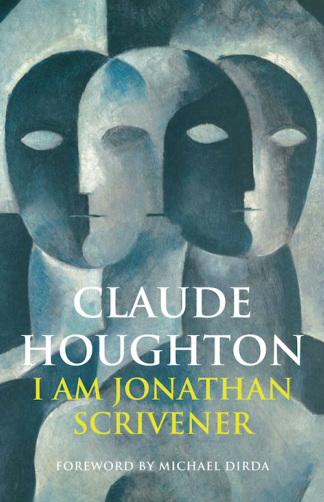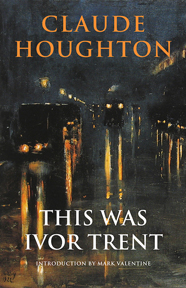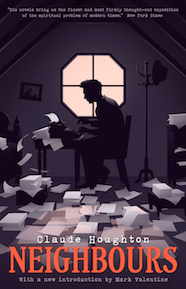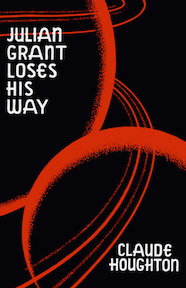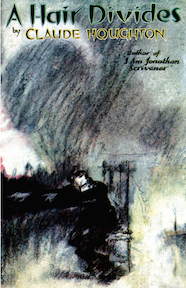|
BOOK DETAILS
Trade paper ISBN-13: 978-1939140081 List Price: $17.99 U.S. Pages: 280 Published: 2013 |
I Am Jonathan Scrivener (1930)
Claude Houghton With a foreword by Michael Dirda Book Description
James Wrexham is thirty-nine, lonely, and stuck in a dead-end job when he comes upon an advertisement for a position as secretary to Mr. Jonathan Scrivener. Much to his surprise, he is hired at a lavish salary despite never even meeting Scrivener, and he is told to take up residence at once in the flat of his new employer, who has suddenly disappeared. Mystified by Scrivener’s strange conduct and desperate to learn something about him, it seems Wrexham will get the answers he seeks when Scrivener’s friends begin to visit the flat: Pauline Mandeville, an ethereal beauty, Francesca Bellamy, a widow who may be responsible for the death of her husband, Andrew Middleton, a disillusioned alcoholic, and Antony Rivers, a handsome playboy. But as each of them unfolds his story about Scrivener, it seems that none of them are describing the same person, though all are obsessed with finding him. Why has he hired Wrexham, and why does he seem to have thrust this unlikely group of people together? Is Scrivener engaged in an inscrutable experiment, or could he be laying some kind of trap? Popular in his time for his psychological thrillers, Claude Houghton (1889-1961) was admired by writers as diverse as P. G. Wodehouse, Henry Miller, Hugh Walpole, and Graham Greene, but has fallen into neglect in the past half-century. This new edition restores his masterpiece I Am Jonathan Scrivener (1930) to print and includes Walpole’s introduction from the 1935 edition and an essay by Pulitzer Prize-winning critic and Washington Post columnist Michael Dirda. |
reviews
“Elegant, unsettling . . . Variously evoking P.G. Wodehouse's wit and G.K. Chesterton's cerebral thrillers, this thoughtful puzzle of a novel should strike readers as a still-fresh discovery.” - Publishers Weekly, July 2013
“[I]t should be a worthwhile discovery for anyone: it remains as unputdownable as it famously was in the 1930s.” – Phil Baker, Times Literary Supplement
“I defy anybody to put down the book until the last page be reached.” – Ralph Straus, Sunday Times
“Here is a novel that has fascination, wit, suspense and a grand motivating idea. . . . I could easily believe it the most brilliant work of its kind for 1930. . . . [Y]ou will be entertained and beguiled by a pretty wit, a brilliant gift for situations and a sense of mystery that will make you want to skip pages.” – Pittsburgh Press
“The novels of this young British story teller just can’t be shoved into any recognized category . . . his superbly plotted stories have a psychological tension which is unique in the literature of the day.” – Milwaukee Sentinel
“So remarkable in truth is this novel that I cannot understand why it is not universally known and admired.” - Hugh Walpole
“I Am Jonathan Scrivener remains a tantalizing, highly diverting philosophical novel of rare elegance and wit.” - Michael Dirda
“[I]t should be a worthwhile discovery for anyone: it remains as unputdownable as it famously was in the 1930s.” – Phil Baker, Times Literary Supplement
“I defy anybody to put down the book until the last page be reached.” – Ralph Straus, Sunday Times
“Here is a novel that has fascination, wit, suspense and a grand motivating idea. . . . I could easily believe it the most brilliant work of its kind for 1930. . . . [Y]ou will be entertained and beguiled by a pretty wit, a brilliant gift for situations and a sense of mystery that will make you want to skip pages.” – Pittsburgh Press
“The novels of this young British story teller just can’t be shoved into any recognized category . . . his superbly plotted stories have a psychological tension which is unique in the literature of the day.” – Milwaukee Sentinel
“So remarkable in truth is this novel that I cannot understand why it is not universally known and admired.” - Hugh Walpole
“I Am Jonathan Scrivener remains a tantalizing, highly diverting philosophical novel of rare elegance and wit.” - Michael Dirda
ALSO AVAILABLE THROUGH ONLINE RETAILERS
MORE TITLES BY THIS AUTHOR
AUTHOR BIOGRAPHY
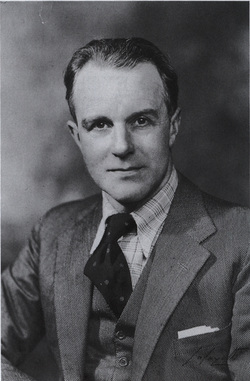
Claude Houghton Oldfield was born in 1889 in Sevenoaks, Kent and was educated at Dulwich College. He trained as an accountant and worked in the Admiralty in the First World War, rejected for active service by poor eyesight. In 1920 he married a West End actress, Dulcie Benson, and they lived in a cottage in the Chiltern Hills. To a writers’ directory, Houghton gave his hobbies as reading in bed, riding, visiting Devon and abroad, and talking to people different to himself. He added: “I like dawn, and the dead of night, in great cities.” He disliked fuss, noise, crowds, rows, and being misquoted, or being told how much he owed “to some writer I’ve never read”.
Houghton’s earliest writing was poetry and drama before turning to prose fiction with his first novel, Neighbours, in 1926. In the 1930s, Houghton published several well-received novels that met with solid sales and respectable reviews, including I Am Jonathan Scrivener (1930), easily his most popular and best-known work, Chaos Is Come Again (1932), Julian Grant Loses His Way (1933), This Was Ivor Trent (1935), Strangers (1938), and Hudson Rejoins the Herd (1939). Although he published nearly a dozen more novels throughout the 1940s and 1950s, most critics feel his later works are less significant than his novels of the 1930s.
Houghton was a prolific correspondent, generous in devoting his time to answering letters and signing copies for readers who enjoyed his books. One of these was novelist Henry Miller, who never met Houghton but began an impassioned epistolary exchange with him after being profoundly moved by his works. Houghton’s other admirers included his contemporaries P. G. Wodehouse, Clemence Dane, and Hugh Walpole. Houghton died in 1961.
Houghton’s earliest writing was poetry and drama before turning to prose fiction with his first novel, Neighbours, in 1926. In the 1930s, Houghton published several well-received novels that met with solid sales and respectable reviews, including I Am Jonathan Scrivener (1930), easily his most popular and best-known work, Chaos Is Come Again (1932), Julian Grant Loses His Way (1933), This Was Ivor Trent (1935), Strangers (1938), and Hudson Rejoins the Herd (1939). Although he published nearly a dozen more novels throughout the 1940s and 1950s, most critics feel his later works are less significant than his novels of the 1930s.
Houghton was a prolific correspondent, generous in devoting his time to answering letters and signing copies for readers who enjoyed his books. One of these was novelist Henry Miller, who never met Houghton but began an impassioned epistolary exchange with him after being profoundly moved by his works. Houghton’s other admirers included his contemporaries P. G. Wodehouse, Clemence Dane, and Hugh Walpole. Houghton died in 1961.

